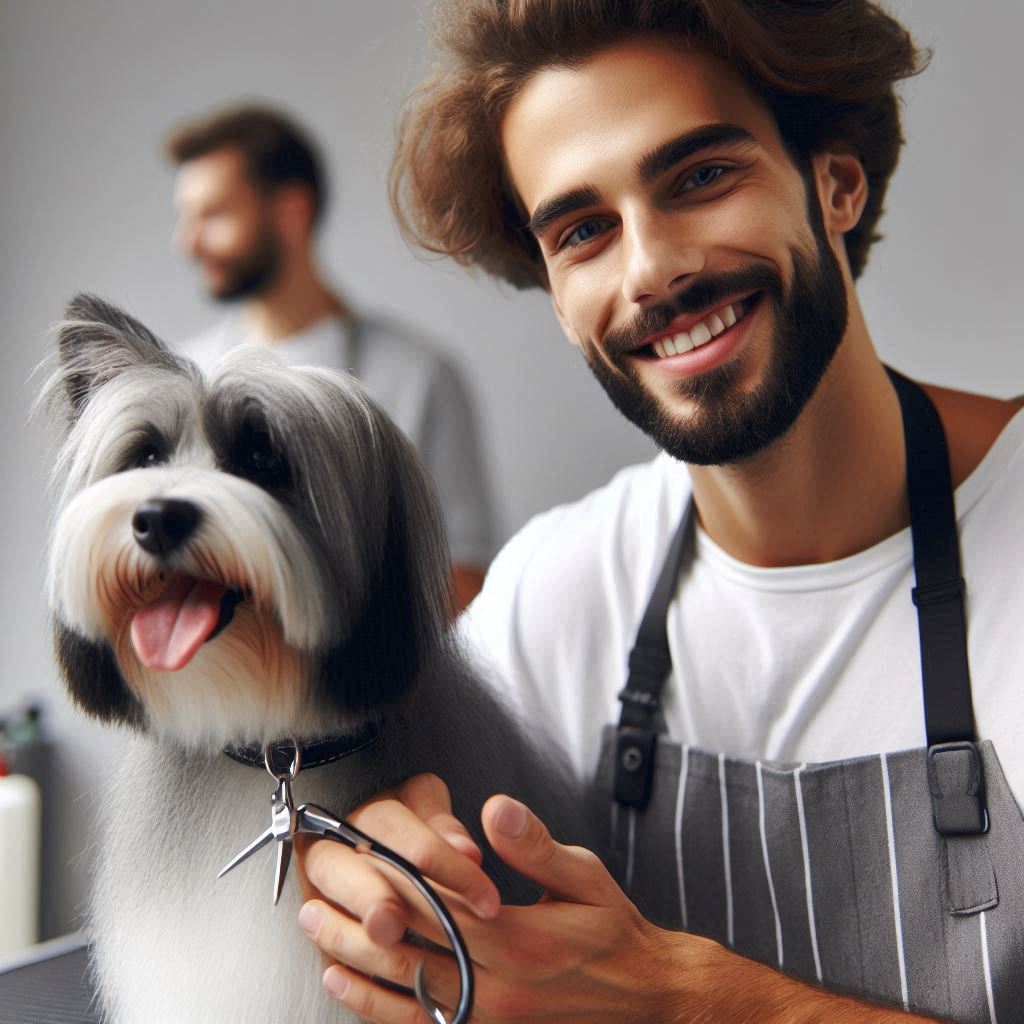Introduction
Grooming difficult pets can be a daunting task for pet owners and groomers alike.
It is essential to maintain proper grooming for pets to ensure their cleanliness and overall well-being.
However, handling challenging animals during grooming can present various challenges that require patience and skill.
With the right tips and techniques, grooming difficult pets can become a stress-free experience both for the pet and the groomer.
By understanding how to handle these situations effectively, you can provide a safe and comfortable grooming experience for even the most temperamental pets.
Understanding pet behavior
Importance of understanding pet behavior before beginning the grooming process
Understanding pet behavior is essential before starting any grooming session.
It allows you to handle pets more safely and effectively.
Every pet has unique triggers and comfort zones that impact how they react to grooming.
Some pets may be nervous around unfamiliar equipment, while others might fear water or being handled.
Observing these cues can prevent stressful situations.
How knowing the animal’s triggers and comfort zones can help in handling difficult pets effectively
Knowing a pet’s triggers helps you adjust your approach and make the process smoother.
For example, if a dog dislikes the sound of clippers, using quieter tools can help reduce anxiety.
Recognizing comfort zones, such as the pet’s preferred way to be touched, can also build trust.
When pets feel comfortable, they are less likely to resist grooming.
Tips on how to observe and assess a pet’s behavior during grooming
During grooming, it’s crucial to assess the pet’s behavior continuously.
Watch for signs of discomfort like growling, stiff body language, or pulling away.
These signs indicate that the pet is feeling stressed or threatened.
By paying attention to these cues, you can make adjustments to help the pet relax.
To handle difficult pets, start by using a calm and patient approach.
Avoid sudden movements, as they may trigger fear or aggression.
Transform Your Career Today
Unlock a personalized career strategy that drives real results. Get tailored advice and a roadmap designed just for you.
Start NowSpeak to the pet in a soothing voice to reassure them throughout the session.
Always give the pet breaks when needed to avoid overwhelming them.
In essence, understanding pet behavior is a vital part of successful grooming.
Knowing the animal’s triggers and comfort zones, along with careful observation, helps you create a safe and stress-free environment for both you and the pet.
Read: How to Market Your Pet Grooming Services Effectively
Creating a calm environment
Creating a calm environment is essential when handling difficult pets during grooming sessions.
Most pets are naturally apprehensive about grooming, so setting the right atmosphere can help them relax and feel more comfortable.
Here are some tips to create a calming environment:
Play soothing music
Soft, classical music or nature sounds can have a calming effect on pets.
Create a playlist specifically for grooming sessions to help your pet relax and feel at ease.
Use aromatherapy
Essential oils like lavender or chamomile can help reduce anxiety in pets.
Try using a diffuser with these calming scents in the grooming area to create a peaceful environment.
Minimize distractions
Keep the grooming area free from loud noises or sudden movements that can startle your pet.
Close windows or doors to block outside distractions and help your pet stay focused on the grooming process.
Dim the lights
Soft, dim lighting can help create a cozy and relaxing atmosphere for your pet.
Avoid bright overhead lights that can be harsh and unsettling during grooming sessions.
By following these tips, you can create a calm and soothing environment that will make grooming sessions more manageable for both you and your pet.
Read: Top Certifications for Pet Groomers in America
Building trust and rapport
Building trust and rapport with a difficult pet is crucial for a successful grooming session.
Pets that feel comfortable and safe are more likely to cooperate during grooming.
Transform Your Career Today
Unlock a personalized career strategy that drives real results. Get tailored advice and a roadmap designed just for you.
Start NowHere are some strategies to help you establish trust and rapport with your furry friend:
Patience is key
Take your time and allow the pet to get used to your presence.
Avoid rushing into the grooming process, as it can cause unnecessary stress and fear.
Use treats and positive reinforcement
Rewards can go a long way in gaining a pet’s trust.
Offer treats throughout the grooming session to create a positive association with the experience.
Create a safe environment
Ensure the grooming area is calm and free from distractions.
This will help the pet feel more at ease and less anxious during the grooming process.
Establish a routine
Pets thrive on routine, so try to establish a grooming routine that the pet can become familiar with.
Consistency can help reduce anxiety and fear.
Communicate with the pet
Use a calm and reassuring tone when interacting with the pet.
Speak softly and provide gentle reassurance throughout the grooming session to help build trust.
Respect the pet’s boundaries
Pay attention to the pet’s body language and respect their boundaries.
If the pet seems uncomfortable or fearful, take a step back and give them some space.
Offer breaks as needed
If the pet becomes overwhelmed during the grooming session, offer short breaks to allow them to relax.
This can help prevent the pet from becoming too stressed.
Seek professional help if needed
If you’re struggling to build trust with a difficult pet, don’t hesitate to seek help from a professional groomer or animal behaviorist.
They can provide valuable insights and guidance on how to establish trust with your pet.
By following these strategies and tips, you can build trust and rapport with your pet, making grooming sessions a more pleasant and stress-free experience for both you and your furry friend.
Read: How to Create a Safe Environment in Childcare Settings

Using gentle handling techniques
When dealing with difficult pets during grooming, it is crucial to prioritize gentle handling techniques to ensure the safety and comfort of the animal.
Transform Your Career Today
Unlock a personalized career strategy that drives real results. Get tailored advice and a roadmap designed just for you.
Start NowBy taking a calm and patient approach, you can effectively manage challenging behaviors and make the grooming process more manageable for both you and the pet.
Benefits of Gentle Handling Techniques
- Reduce stress and anxiety: Gentle handling helps to alleviate fear and anxiety in pets, making them more cooperative during grooming sessions.
- Build trust: By handling the pet gently, you can establish trust and rapport, creating a positive grooming experience for the animal.
- Prevent injuries: Rough handling can lead to injuries or accidents, so it is essential to use gentle techniques to avoid harm to the pet.
Tips for Gentle Handling
- Approach the pet calmly: Avoid sudden movements or loud noises that can startle the animal.
Speak softly and move slowly to reassure the pet. - Use positive reinforcement: Reward good behavior with treats or praise to encourage the pet to cooperate during grooming tasks.
- Focus on sensitive areas: Be gentle when handling sensitive areas such as ears, paws, and tail to prevent discomfort or pain.
- Take breaks when needed: If the pet becomes agitated or stressed, take breaks to allow the animal to relax before continuing with grooming.
- Use the right tools: Choose grooming tools that are gentle on the pet’s skin and coat to minimize the risk of irritation or injury.
- Seek professional help: If you are struggling to handle a difficult pet, consider seeking help from a professional groomer or trainer for guidance.
Importance of Patience
Patience is key when dealing with difficult pets during grooming.
It is essential to remain calm and composed, even if the pet exhibits challenging behavior.
By staying patient and persistent, you can gradually build trust and cooperation with the animal.
Grooming a difficult pet can be a challenging task, but with gentle handling techniques and patience, you can make the experience more pleasant for both you and the animal.
Remember to prioritize the well-being and comfort of the pet throughout the grooming process to ensure a successful outcome.
Read: Interview Tips for Aspiring Childcare Workers
Patience and Consistency
Dealing with difficult pets during grooming requires a great deal of patience and consistency.
Here are some valuable tips on how to handle challenging behavior:
Value of Patience
- Understand that pets may be fearful or anxious during grooming.
- Take your time and allow the pet to adjust to the grooming process.
- Avoid rushing through the grooming session, as it can escalate stress.
- Patience will help build trust between you and the pet, making future grooming sessions easier.
Remaining Calm and Composed
- Take deep breaths and stay calm when faced with challenging behavior.
- Avoid reacting impulsively or getting frustrated, as it can worsen the situation.
- Use a soothing voice and gentle touch to reassure the pet during grooming.
- Remember that your positive energy can help relax the pet and improve their behavior.
Consistency in Grooming Routine
- Stick to a regular grooming schedule to establish a routine for the pet.
- Use the same tools and techniques during grooming sessions to create familiarity.
- Start with short grooming sessions and gradually increase the time as the pet becomes more comfortable.
- Consistency will help the pet know what to expect, reducing anxiety and fear during grooming.
Overall, patience and consistency are key when handling difficult pets during grooming.
By staying calm, composed, and maintaining a routine, you can help your pet feel more comfortable and relaxed over time.
Seeking professional help
How handling difficult pets during grooming can be challenging
When dealing with difficult pets during grooming, it’s essential to recognize that not all pet owners have the expertise or experience to handle such situations.
Seeking professional help is a great option for those who may be struggling with their pets’ behavior.
How a professional can assess the pet’s behavior and offer guidance on handling difficult animals
Professional groomers and trainers are equipped with the knowledge and skills to assess a pet’s behavior and offer appropriate guidance on how to handle difficult animals.
They can provide valuable insights and strategies to help pet owners manage their pets effectively during grooming sessions.
It’s essential for pet owners to understand that asking for help is not a sign of weakness but a smart and responsible decision.
Professional groomers and trainers have the experience and expertise to deal with a wide range of pet behaviors, making them well-equipped to assist in challenging situations.
Encouraging pet owners to reach out for support if they feel overwhelmed or unable to groom their pet safely
By reaching out to a professional, pet owners can ensure the safety and well-being of their pets during grooming.
Professional help can prevent accidents or injuries that may result from handling difficult animals without the necessary skills or knowledge.
Overall, seeking professional help is a proactive step that pet owners can take to ensure a positive and successful grooming experience for both themselves and their pets.
Transform Your Career Today
Unlock a personalized career strategy that drives real results. Get tailored advice and a roadmap designed just for you.
Start NowIt’s important to prioritize the safety and comfort of the pet, and seeking assistance from a professional is a great way to achieve that goal.
Using the right grooming tools
When it comes to grooming difficult pets, using the right grooming tools is crucial for a successful grooming session.
Here are some key points to consider:
Importance of Using the Right Grooming Tools
- Using the right grooming tools can make the grooming process more efficient and less stressful for both you and your pet.
- Each pet has different coat types and textures, so using the appropriate tools ensures that you are addressing their specific grooming needs.
- Using the wrong tools can lead to injuries or discomfort for your pet, so it’s important to choose wisely.
Recommended Grooming Tools
- Slicker brushes are great for removing mats and tangles in pets with long or curly coats.
- For pets with thick undercoats, a deshedding tool can help reduce shedding and prevent matting.
- Nail clippers should be sharp and easy to use to prevent accidents during nail trimming.
- Grooming gloves are a gentle option for pets who are afraid of traditional grooming tools.
Tips for Choosing and Maintaining Grooming Tools
- Do research to find the best grooming tools for your pet’s specific coat type and grooming needs.
- Choose tools that are safe, comfortable, and easy to use to ensure a positive grooming experience.
- Regularly clean and sanitize your grooming tools to prevent the spread of bacteria and keep them in top condition.
- Replace any damaged or worn-out tools to ensure that you are grooming your pet effectively and safely.
By using the right grooming tools and maintaining them properly, you can ensure that grooming difficult pets is a smooth and successful process.
Remember to always prioritize your pet’s comfort and safety during grooming sessions.
Conclusion
Handling difficult pets during grooming requires patience and skill.
Keeping a calm environment is crucial.
Consistency is key in implementing these tips effectively.
Seeking professional help when needed ensures the safety of pets.
Remember, gentle handling is paramount in the grooming process.
Make sure to practice these techniques regularly for successful grooming sessions.
Your pet’s well-being depends on it.
[E-Books for Sale]
The Big Book of 500 High-Paying Jobs in America: Unlock Your Earning Potential
$19.99 • 500 High-Paying Jobs • 330 pages
Explore 500 high-paying jobs in America and learn how to boost your career, earn more, and achieve success!
See All 500 High-Paying Jobs of this E-Book
1001 Professions Without a Degree: High-Paying American Jobs You Can Start Now
$19.99 • 1001 Professions Without a Degree • 174 pages
Discover 1001 high-paying jobs without a degree! Unlock career tips, skills, and success strategies for just $19.99!




